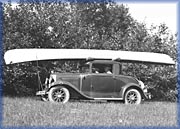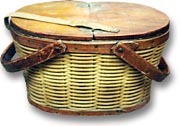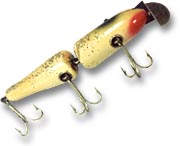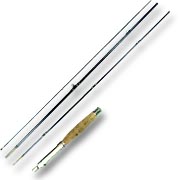|
The Buzzwagon
Thanks to the automobile, everyone could be a
sport fisherman.
 n its early years, the
automobile's high cost made it a rich man's toy, vilified by rural
people as a "buzzwagon" that scared livestock and threatened life
and limb. Auto enthusiasts thought of themselves quite differently.
They were gypsies - albeit well-off gypsies - out for
adventure and relaxation in harmony with nature. n its early years, the
automobile's high cost made it a rich man's toy, vilified by rural
people as a "buzzwagon" that scared livestock and threatened life
and limb. Auto enthusiasts thought of themselves quite differently.
They were gypsies - albeit well-off gypsies - out for
adventure and relaxation in harmony with nature.
|

|

Harry Chestnut in his roadster with a canoe
on the roof, early 1930s
Harry and his brother Will Chestnut founded the Chestnut Canoe
Company in Fredericton at the turn of the 20th century.
(Harvey Studios, Fredericton, New Brunswick)
|
|
With mass production came lower cost and an improving road network.
Between 1910 and 1923, the number of motor vehicles registered in
New Brunswick grew from 300 to 6,500. New Englanders owned vastly
more cars, a fact not lost on the government, which created the
New Brunswick Bureau of Information and Tourism in 1927.
"Auto-camping," with tents, picnic baskets, and fishing tackle
stowed in car trunks, became a popular pastime. Atlantic salmon
anglers could motor to their clubs and fishing grounds, but the
car-driving crowd was also attracted by New Brunswick's trout,
pickerel, and landlocked salmon.
|

|
Refrigerator basket,
probably a Hawkeye, with an ice compartment inside and sealed
with hair felt, about 1910. This basket was suitable for taking
lunch to the river and carrying trout home.
(New Brunswick Museum, 974.192.154)
|

|

A jointed wooden lure,
stamped "Pikie" in gold at the top and "C.C.B. Co., Garrett,
Indiana" on the metal diving lip. The Creek Chub Bait Company was
using its initials in advertising by the late teens, when this
lure was probably manufactured.
(Collection of Gary Hughes)
|

|

Walton steel 7 ½- foot bait
or lure casting rod, patented August 20, 1907
Steel rods enjoyed some popularity in the first quarter of
the 20th century, but they never became as common as bamboo rods.
(Collection of Gary Hughes)
|
|
|
|
|
|



